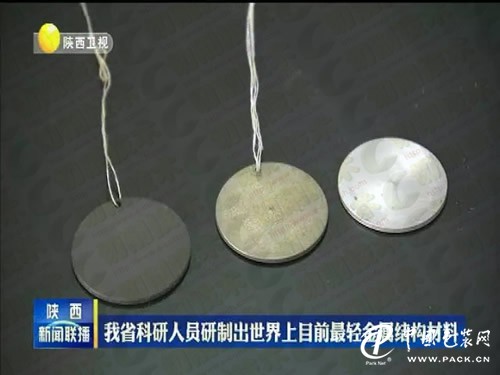
[Chinese Packaging News] A new type of magnesium-lithium alloy, the lightest metal structural material in the world, has recently become a hot spot for media attention. The material was developed by Prof. Chai Donglang and team of Xi'an Jiaotong University. It has been applied to high-resolution micro-nano satellites in China's first global CO2 monitoring science experimental satellite. People’s Daily Online, Shaanxi TV News Network, and Shaanxi News Media have recently paid attention to reports.
Magnesium-lithium alloy material is made by adding metallic lithium to metallic magnesium, which has excellent mechanical properties such as low density, high specific stiffness, high specific strength, high damping performance of shock absorption and noise elimination, and resistance to radiation and electromagnetic interference. Performance represents the technological frontier of the development of magnesium alloys and is known as the most revolutionary material in the future. Compared with aluminum alloy, the same size, the weight is only half of the aluminum alloy, but the specific strength is higher than the aluminum alloy. In addition, this new type of magnesium-lithium alloy has excellent damping performance, which is more than ten times that of aluminum alloys. It has a good shock absorption and noise reduction effect, and it has outstanding performance in shielding electromagnetic interference.
Magnesium-lithium alloy materials significantly reduce the weight of satellites, significantly increase payload, and reduce launch costs. These unparalleled advantages make it widely used in military and civilian fields such as aerospace, weapons and military, electronic products, petrochemicals, mechanical instruments, medical equipment, and outdoor equipment. In September 2015, this material was used for the first time on China’s Pujiang-1 satellite. In December 2016, almost all of the ultra-light materials independently developed and produced by China were used on high-resolution micro-nano satellites in China’s first global carbon dioxide monitoring scientific experiment satellite (“carbon satelliteâ€) successfully launched by China.
Chai Donglang said in an interview with reporters: “The most important feature of magnesium-lithium alloy is its relatively low density. The place where magnesium-lithium alloys are used is now basically aerospace. It is intended to be used in civilian applications, the casing of a laptop computer, and the casing of a mobile phone. There are a number of other electronic products, including cameras, camera housings, etc. These are all required to be light-weighted and will be ready for use in this direction."
The Shaanxi Province magnesium-lithium alloy engineering research center was approved by the Shaanxi Provincial Development and Reform Commission. Xi'an Sifang Ultralight Materials Co., Ltd. combined with the school's Professor Chai Donglang and the team to undertake the construction. After years of research and development, the center has now developed three models of ultra-light magnesium-lithium alloys with independent intellectual property rights, and also drafted China's first National Standard for Magnesium Alloy Ingots.